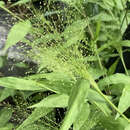Description
provided by eFloras
Annual, delicate. Culms geniculately ascending, rooting from lower nodes, 10–80 cm tall, branched, nodes puberulous. Leaves cauline; leaf sheaths striate, pilose or hispid; leaf blades lanceolate, membranous, 3–8 × 0.5–2 cm, pilose, base asymmetrically cordate or narrowed, apex acuminate; ligule ca. 0.2 mm, a ciliolate membrane. Panicle ovate or oblong in outline, 4–20 cm, much branched; branches fine and bearing the spikelets on long pedicels. Spikelets asymmetrically ovate, 1–1.5 mm, pubescent; lower glume ovate, 1/2 length of spikelet, 1–3-veined, separated by an internode; upper glume as long as spikelet, 3–5-veined; lower lemma similar to upper glume, palea 1/2 as long as lemma; upper floret as long as spikelet, thinly coriaceous, glabrous, white, granulose. Fl. and fr. Sep–Dec. 2n = 18.
- license
- cc-by-nc-sa-3.0
- copyright
- Missouri Botanical Garden, 4344 Shaw Boulevard, St. Louis, MO, 63110 USA
Habitat & Distribution
provided by eFloras
Roadsides, waste places. Guangdong, Hainan [tropical America; introduced in tropical Africa and Asia].
- license
- cc-by-nc-sa-3.0
- copyright
- Missouri Botanical Garden, 4344 Shaw Boulevard, St. Louis, MO, 63110 USA
Comprehensive Description
provided by North American Flora
Panicum trichoides Sw. Prodr. 24. 1788
Panicum capillaceum Lam. Tab. Encyc. 1: 173. 1791.
Panicum acutifolium Willd.; Spreng. Syst. 1: 320, as synonym. 1825.
Panicum capillaceum strictius Doell, in Mart. Fl. Bras. 2 2 : 249. 1877.
Plants often widely spreading; culms ascending from a decumbent base, the ascending portion 20-40 cm. high, rather slender, leafy, pubescent; leaf-sheaths short, but sometimes overlapping toward the summit and on the branches, ciliate and papillose-hirsute, at least toward the summit; ligule membranaceous-ciliate, scarcely 0.5 mm. long; blades spreading, thin, 2-6 cm. long, 1-2 cm. wide, ovate or ovate-lanceolate, somewhat asymmetric, acuminate, cordate and somewhat clasping at the ciliate base, glabrous or sparsely hirsute on both surfaces; panicles oval or ovate in outline, 5-20 cm. long, nearly as wide, the axis sparsely pilose, the numerous branches and branchlets and the long pedicels capillary; spikelets 1.2-1.3 mm. long, about 0;5 mm. wide, ob ovate-elliptic, sparsely hirsute; first glume about half the length of the spikelet, acute, 1 -nerved; second glume shorter than the sterile lemma, both 3-nerved, and at maturity sometimes ruptured by the expanding fruit, often only the lower part of each remaining; fruit at maturity 1.3 mm. long, 0.6 mm. wide, elliptic, minutely papillose while immature, becoming smooth but not polished.
Type locality: Jamaica.
Distribution: Mexico and the West Indies to Brazil and Ecuador.
- bibliographic citation
- George Valentine Nash. 1915. (POALES); POACEAE (pars). North American flora. vol 17(3). New York Botanical Garden, New York, NY
Physical Description
provided by USDA PLANTS text
Annuals, Terrestrial, not aquatic, Stems nodes swollen or brittle, Stems geniculate, decumbent, or lax, sometimes rooting at nodes, Stems caespitose, tufted, or clustered, Stems terete, round in cross section, or polygonal, Stems branching above base or distally at nodes, Stem nodes bearded or hairy, Stem internodes hollow, Stems with inflorescence less than 1 m tall, Stems, culms, or scapes exceeding basal leaves, Leaves mostly cauline, Leaves conspicuously 2-ranked, distichous, Leaves sheathing at base, Leaf sheath mostly open, or loose, Leaf sheath hairy, hispid or prickly, Leaf sheath and blade differentiated, Leaf blades lanceolate, Leaf blades ovate, Leaf blades 2-10 mm wide, Leaf blades 1-2 cm wide, Leaf blades mostly flat, Leaf blades more or less hairy, Ligule present, Ligule a fringed, ciliate, or lobed membrane, Inflorescence terminal, Inflorescence an open panicle, openly paniculate, branches spreading, Inflorescence solitary, with 1 spike, fascicle, glomerule, head, or cluster per stem or culm, Inflorescen ce branches more than 10 to numerous, Flowers bisexual, Spikelets pedicellate, Spikelets dorsally compressed or terete, Spikelet less than 3 mm wide, Spikelets with 1 fertile floret, Spikelets with 2 florets, Spikelet with 1 fertile floret and 1-2 sterile florets, Spikelets solitary at rachis nodes, Spikelets all alike and fertille, Spikelets bisexual, Spikelets disarticulating below the glumes, Rachilla or pedicel glabrous, Glumes present, empty bracts, Glumes 2 clearly present, Glumes distinctly unequal, Glumes equal to or longer than adjacent lemma, Glume equal to or longer than spikelet, Glumes 3 nerved, Glumes 4-7 nerved, Lemma similar in texture to glumes, Lemma 5-7 nerved, Lemma glabrous, Lemma rugose, with cross wrinkles, or roughened, Lemma apex truncate, rounded, or obtuse, Lemma awnless, Lemma margins inrolled, tightly covering palea and caryopsis, Lemma straight, Palea present, well developed, Palea about equal to lemma, Stamens 3, Styles 2-fid, deeply 2-branched , Stigmas 2, Fruit - caryopsis, Caryopsis ellipsoid, longitudinally grooved, hilum long-linear.

